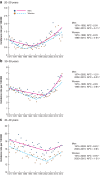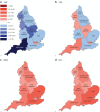Demographic trends in the incidence of young-onset colorectal cancer: a population-based study
- PMID: 32149386
- PMCID: PMC7155067
- DOI: 10.1002/bjs.11486
Demographic trends in the incidence of young-onset colorectal cancer: a population-based study
Abstract
Background: Evidence is emerging that the incidence of colorectal cancer is increasing in young adults, but the descriptive epidemiology required to better understand these trends is currently lacking.
Methods: A population-based cohort study was carried out including all adults aged 20-49 years diagnosed with colorectal cancer in England between 1974 and 2015. Data were extracted from the National Cancer Registration and Analysis Service database using ICD-9/10 codes for colorectal cancer. Temporal trends in age-specific incidence rates according to sex, anatomical subsite, index of multiple deprivation quintile and geographical region were analysed using Joinpoint regression.
Results: A total of 56 134 new diagnoses of colorectal cancer were analysed. The most sustained increase in incidence rate was in the group aged 20-29 years, which was mainly driven by a rise in distal tumours. The magnitude of incident rate increases was similar in both sexes and across Index of Multiple Deprivation quintiles, although the most pronounced increases in incidence occurred in the southern regions of England.
Conclusion: Colorectal cancer should no longer be considered a disease of older people. Changes in incidence rates should be used to inform future screening policy, preventative strategies and research agendas, as well as increasing public understanding that younger people need to be aware of the symptoms of colorectal cancer.
Antecedentes: Están apareciendo evidencias de que la incidencia del cáncer colorrectal (colorectal cancer, CRC) está aumentando en adultos jóvenes, pero se carece de la epidemiología descriptiva necesaria para comprender mejor estas tendencias. MÉTODOS: Se realizó un estudio de cohortes de base poblacional de todos los adultos de 20 a 49 años diagnosticados de CRC en Inglaterra entre 1974 y 2015. Los datos se extrajeron de la base de datos NCRAS utilizando los códigos ICD9/10 para el CRC. Las tendencias temporales en las tasas de incidencia específicas por edad (incidence rates, IR) según el sexo, la localización anatómica, el quintil del índice de privación múltiple (index of multiple deprivation, IMD) y la región geográfica se analizaron mediante un modelo de regresión joinpoint.
Resultados: Se analizaron un total de 56.134 nuevos diagnósticos de CRC. El aumento más sostenido en la IR se produjo en el grupo de edad de 20 a 29 años, principalmente a expensas de un incremento de los tumores distales. La magnitud de los aumentos de IR fue similar en ambos sexos y en los quintiles del IMD, aunque los aumentos más pronunciados en la incidencia se registraron en las regiones del sur de Inglaterra. CONCLUSIÓN: El CRC ya no debe ser considerado una enfermedad de las personas mayores: los cambios en las tasas de incidencia deberán tenerse en cuenta en las futuras políticas de cribado, en las estrategias preventivas y en los proyectos de investigación, así como para aumentar la toma de conciencia de la población de que las personas más jóvenes deben estar al corriente de los síntomas del CRC.
© 2020 The Authors. BJS published by John Wiley & Sons Ltd on behalf of BJS Society Ltd.
Figures




References
-
- Stewart B, Wild C. World Cancer Report 2014 International Agency for Research on Cancer: Lyon, 2014.
-
- Cancer Research UK . Bowel Cancer Statistics http://www.cancerresearchuk.org/health-professional/cancer-statistics/st... [accessed 17 November 2019].
-
- Arnold M, Sierra MS, Laversanne M, Soerjomataram I, Jemal A, Bray F. Global patterns and trends in colorectal cancer incidence and mortality. Gut 2017; 66: 683–691. - PubMed
-
- Patel P, De P. Trends in colorectal cancer incidence and related lifestyle risk factors in 15–49‐year‐olds in Canada, 1969‐2010. Cancer Epidemiol 2016; 42: 90–100. - PubMed
Publication types
MeSH terms
Grants and funding
LinkOut - more resources
Full Text Sources
Medical

